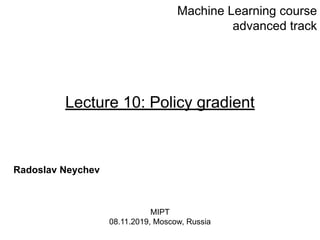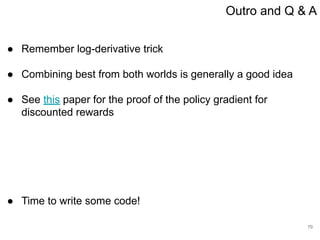This document summarizes the policy gradient reinforcement learning algorithm. It begins by introducing the objective of directly maximizing expected reward over a policy. It then derives the policy gradient theorem, which allows calculating the analytical gradient of the expected reward with respect to the policy parameters. This is used to develop the REINFORCE algorithm, which approximates the policy gradient using sampled episodes. REINFORCE estimates state-action values to compute the policy gradient and updates the policy in the direction of increasing expected reward. Baseline functions can be subtracted from the state-action values to reduce variance in the policy gradient estimate.







![7
Approximation error
DQN is trained to minimize
Simple 2-state world
L≈E[Q(st ,at)−(rt +γ⋅maxa' Q(st+1, a'))]
2
True (A) (B)
Q(s0,a0) 1 1 2
Q(s0,a1) 2 2 1
Q(s1,a0) 3 3 3
Q(s1,a1) 100 50 100
Q: Which prediction is better (A/B)?](https://image.slidesharecdn.com/week10reinforce-230518183738-6039f71d/85/week10_Reinforce-pdf-8-320.jpg)
![8
Approximation error
DQN is trained to minimize
Simple 2-state world
L≈E[Q(st ,at)−(rt +γ⋅maxa' Q(st+1, a'))]
2
True (A) (B)
Q(s0,a0) 1 1 2
Q(s0,a1) 2 2 1
Q(s1,a0) 3 3 3
Q(s1,a1) 100 50 100
better
policy
less
MSE](https://image.slidesharecdn.com/week10reinforce-230518183738-6039f71d/85/week10_Reinforce-pdf-9-320.jpg)
![9
Approximation error
DQN is trained to minimize
Simple 2-state world
L≈E[Q(st ,at)−(rt +γ⋅maxa' Q(st+1, a'))]
2
True (A) (B)
Q(s0,a0) 1 1 2
Q(s0,a1) 2 2 1
Q(s1,a0) 3 3 3
Q(s1,a1) 100 50 100
better
policy
less
MSE
Q-learning will prefer worse policy (B)!](https://image.slidesharecdn.com/week10reinforce-230518183738-6039f71d/85/week10_Reinforce-pdf-10-320.jpg)


![12
NOT how humans survived
argmax[
Q(s,pet the tiger)
Q(s,run from tiger)
Q(s,provoke tiger)
Q(s,ignore tiger)
]](https://image.slidesharecdn.com/week10reinforce-230518183738-6039f71d/85/week10_Reinforce-pdf-13-320.jpg)






![19
Recap: crossentropy method
● Initialize NN weights
● Loop:
– Sample N sessions
– elite = take M best sessions and concatenate
θ0←random
θi+1=θi+α ∇ ∑
i
log πθi
(ai∣si)⋅
[ si ,ai∈Elite]](https://image.slidesharecdn.com/week10reinforce-230518183738-6039f71d/85/week10_Reinforce-pdf-20-320.jpg)
![20
Recap: crossentropy method
● Initialize NN weights
● Loop:
– Sample N sessions
– elite = take M best sessions and concatenate
TD version: elite (s,a) that have highest G(s,a)
(select elites independently from each state)
θ0←random
θi+1=θi+α ∇ ∑
i
log πθi
(ai∣si)⋅
[ si ,ai∈Elite]](https://image.slidesharecdn.com/week10reinforce-230518183738-6039f71d/85/week10_Reinforce-pdf-21-320.jpg)


















![39
Discounted reward case
● Replace R with Q :)
π⋅∇ log π(z)=∇ π( z)
that's expectation :)
∇ J=∫
s
p(s)∫
a
∇ πθ (a∣s)Q(s,a)dads
∇ J=∫
s
p(s)∫
a
πθ (a∣s)∇ log πθ(a∣s)Q(s,a)dads
True action value
a.k.a. E[ G(s,a) ]](https://image.slidesharecdn.com/week10reinforce-230518183738-6039f71d/85/week10_Reinforce-pdf-40-320.jpg)













![53
REINFORCE baselines
● Gradient direction stays the same
● Variance may change
Gradient variance:
as a random variable over (s, a)
∇ J
Var[Q(s,a)−b(s)]
Var[Q(s,a)]−2⋅Cov[Q(s ,a),b(s)]+Var[b(s)]](https://image.slidesharecdn.com/week10reinforce-230518183738-6039f71d/85/week10_Reinforce-pdf-54-320.jpg)
![54
REINFORCE baselines
● Gradient direction stays the same
● Variance may change
Gradient variance:
as a random variable over (s, a)
∇ J
Var[Q(s,a)−b(s)]
If b(s) correlates with Q(s,a), variance decreases
Var[Q(s,a)]−2⋅Cov[Q(s ,a),b(s)]+Var[b(s)]](https://image.slidesharecdn.com/week10reinforce-230518183738-6039f71d/85/week10_Reinforce-pdf-55-320.jpg)
![55
REINFORCE baselines
● Gradient direction stays the same
● Variance may change
Gradient variance:
as a random variable over (s, a)
∇ J
Var[Q(s,a)−b(s)]
Q: can you suggest any such b(s)?
Var[Q(s,a)]−2⋅Cov[Q(s ,a),b(s)]+Var[b(s)]](https://image.slidesharecdn.com/week10reinforce-230518183738-6039f71d/85/week10_Reinforce-pdf-56-320.jpg)
![56
REINFORCE baselines
● Gradient direction stays the same
● Variance may change
Gradient variance:
as a random variable over (s, a)
∇ J
Var[Q(s,a)−b(s)]
Naive baseline: b = moving average Q
over all (s, a), Var[b(s)] = 0, Cov[Q, b] > 0
Var[Q(s,a)]−2⋅Cov[Q(s ,a),b(s)]+Var[b(s)]](https://image.slidesharecdn.com/week10reinforce-230518183738-6039f71d/85/week10_Reinforce-pdf-57-320.jpg)






![63
Advantage actor-critic
∇ Jactor≈
1
N
∑
i=0
N
∑
s,a∈zi
∇ logπθ(a∣s)⋅A(s ,a)
Vθ(s)
model
W = params
state s
πθ(a∣s)
Lcritic≈
1
N
∑
i=0
N
∑
s,a∈zi
(V θ(s)−[r+γ⋅V (s')])
2
Improve policy:
Improve value:](https://image.slidesharecdn.com/week10reinforce-230518183738-6039f71d/85/week10_Reinforce-pdf-64-320.jpg)






